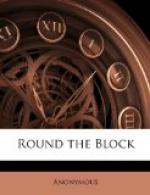He looked at the witness—the holy idol of all his romantic and tender thoughts in days gone by—with unruffled composure. The marked stoicism of his demeanor was not lost on the reporters, and they noticed it in paragraphs to the effect that the prisoner exhibited a hardened indifference during the most thrilling portion of the evidence.
QUESTION BY THE CORONER (after thinking it over a bit). “Who do you say struck the fust blow, miss? Remember, now, you’re on oath.”
ANSWER. “My father, sir—or rather, I dreamed so.”
The coroner was disappointed again, for he hoped that the witness would, on second thought, fix the commencement of the actual assault on the prisoner. “Your father, being old and kind o’ feeble, struck a light blow, I s’pose.”
WITNESS. “No, sir—a heavy one, I should judge; for it appeared to cut open Mr. Wilkeson’s lip, and bruise his cheek. The blood seemed to run down his face in a stream.” Here little Pet exhibited signs of faintness, which good Mrs. Crull stopped by an instant application of the smelling bottle.
CORONER. “Mr. Wilkeson struck back a terrible blow in return, I s’pose.”
WITNESS. “Yes, sir. He hit my father right in the eye, raising a black and blue spot as large as a hen’s egg.” The painful recollection of this part of the dream so overpowered the witness, that she burst into tears, but was soon quieted by the motherly attentions of Mrs. Crull.
FOREMAN OF THE JURY. “I don’t want to hurt the young lady’s feelin’s, but this ‘ere dream is all nonsense; and it strikes me we’re a lot o’ fools to be listenin’ to it. Why, Harry, you know, as well as I do, that there wasn’t no bruise on the old man’s face, exceptin’ the big one on his forehead. No more is there a sign of a scratch on the prisoner’s mug there. It’s all gammon.”
Three others of the jury nodded in approval of this sentiment. The remaining two shared somewhat in the coroner’s reverence for dreams, and awaited further developments.
The coroner turned his quid uneasily. “You can think as you please, Jack,” said he: “but we’ll see—we’ll see.” The coroner, like many other men of greater claims to wisdom, used this enigmatical expression when he could not see anything.
A lawyer less crafty than Fayette Overtop would have protested against the reception of this singular testimony at the outset, and at intervals of a minute during its delivery. But he foresaw that, being a dream, it must be full of absurdities, which would surely betray themselves, and help his client. Besides, he was curious to hear all of the evidence, however ridiculous and worthless, against the prisoner.
The witness then proceeded to the close of her testimony, amid the silence of all hearers. The narrative of the dreadful grapple, the struggle for the club, and the death blow given by Mr. Wilkeson to her prostrate father—all delivered with an intense earnestness, broken only by occasional sobs and pauses of anguish—produced a powerful impression. As she finished, and fell, half fainting, into the arms of Mrs. Crull, the coroner nodded his head slowly, and said:




